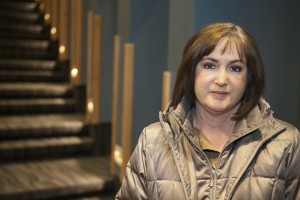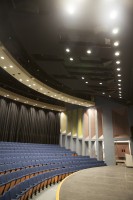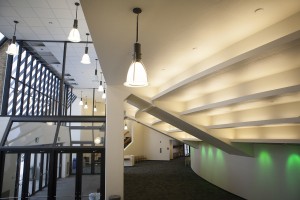Illuminating education
by Tracy Kalytiak |
 A peek into a lecture hall of UAA's Professional Studies Building revealed what most
would expect to see in an Alaska Native anthropology class: students in desks, gazing
up at an audiovisual presentation featuring ravens and eagles. The room was dim enough
to easily see the presentation, yet light enough for students to take notes on what
they were seeing.
A peek into a lecture hall of UAA's Professional Studies Building revealed what most
would expect to see in an Alaska Native anthropology class: students in desks, gazing
up at an audiovisual presentation featuring ravens and eagles. The room was dim enough
to easily see the presentation, yet light enough for students to take notes on what
they were seeing.
"I've taught in PSB 166 many times," said Dr. Phyllis Fast, the professor teaching that anthropology class. "The new lighting is excellent."
New pendant-mounted LED units in the PSB 166 lecture hall use 75 percent less energy, require less maintenance and save thousands of dollars a year. Before, the university spent $3,025 annually to light that hall; now, it will spend about $750 annually, said Patricia Baum, a certified lighting consultant who works as project manager/designer for UAA Facilities, Planning & Construction.
"The existing light fixtures were circa 1980s, using old energy-inefficient technology," Patricia said. "The controls-dimmers-were also old magnetic ballasted technology."
Getting green
The lecture hall looked completely different just three months ago, Patricia said, when old, heavy, torn, dark drapes covered a wall and fluorescent tubes lit the room from recessed fixtures more than 20 feet above, casting a yellow pall. Changing lamps required staff time and a cumbersome lift. Audiovisual presentations took place in a much darker space, since lighting settings were limited to "off" and "on."

Patricia Baum, a certified lighting consultant, works as a project manager/designer
for UAA Facilities, Planning & Construction.
Philip Hall/University of Alaska Anchorage
Workers removed the drapes and painted the walls white, brightening the room with reflected light. A recessed cove provided "perimeter" lighting. A digital control system with four light levels (including AV mode settings) replaced the old magnetic light controls. An instructor can use the controls from his or her lectern, allowing full access during classes, in addition to available controls at the lecture hall entrance.
"I think it is very important to have the proper lighting controls in an educational environment," Patricia said. "Every classroom should have an AV light level by default to allow watching screen presentations in the correct contrast. It is also important to have 'comfortable' lighting levels. This psychologically provides a better frame of mind to engage in learning and teaching with these conditions."
Patricia replaced recessed light fixtures with pendant-mounted LED units that were easier to reach and have a very long life.

Lighting that uses less power and requires fewer maintenance visits brightens the
Wendy Williamson Auditorium.
Philip Hall/University of Alaska Anchorage
"These lamps have a life of approximately 100,000 hours versus 20,000 hours," she said. "Previously, LEDs didn't have the same lumen output as a linear fluorescent lamp. Now, it's totally different. "I'm excited about PSB 166. What that lecture hall represents is how far LEDs have come. They didn't have those yet when we did the Wendy Williamson Auditorium two years ago."
While the Auditorium doesn't have the most up-to-the-minute LED technology, what it does have, now, is a much more modern, energy-efficient, cost-prudent lighting system.
Wendy Williamson Auditorium hosts a variety of events for the UAA and Anchorage communities. Its lobby, corridors and the theater itself contained dozens of old can-style light fixtures housing short-lived incandescent light bulbs. Maintenance staff couldn't keep up with the expensive, unending task of replacing those bulbs, which frequently burned out.

New fluorescent and LED lighting in the Wendy Williamson Auditorium has resulted
in a 67 percent decrease in lighting wattage and a decreased need for maintenance
time.
Philip Hall/University of Alaska Anchorage
Patricia decided to remove the 150-watt, circa-1973 incandescent lamps and replace them with fluorescent and LED lighting, resulting in a 67 percent decrease in lighting wattage and a decreased need for maintenance time. Before, the lights slurped nearly 70,000 watts when they were turned on. Now, they sip just above 20,000 watts.
Renovating the auditorium's lighting system cost $93,089. Another $117,450 paid for new carpeting. New seats were installed in the theater and the old ones recycled. Construction began in November 2011 and ended two months later.
Patricia's attention now focuses on improving lighting in the rooms where students learn. She replaced old fluorescent-tube lighting-"recessed glare bombs," she quipped-with more efficient, brighter LED linear lighting-as a prototype for advanced classroom lighting-in one of the classrooms at Sally Monserud Hall in 2005. Other classrooms followed suit in the Social Sciences Building during the Psychology Department renovations. Facilities, Planning & Construction hopes to expand the more efficient lighting to other UAA classrooms.
The Green Series is a monthly feature highlighting sustainability initiatives at the University of Alaska Anchorage. More than recycling, sustainability is a commitment to the long-term health and vitality of economic, ecological and social systems for future generations. UAA strives to build and maintain sustainable models for northern universities-and communities-through research, action and collaboration.
Written by Tracy Kalytiak, UAA Office of University Advancement.
 "Illuminating education" is licensed under a Creative Commons Attribution-NonCommercial 4.0 International License.
"Illuminating education" is licensed under a Creative Commons Attribution-NonCommercial 4.0 International License.














